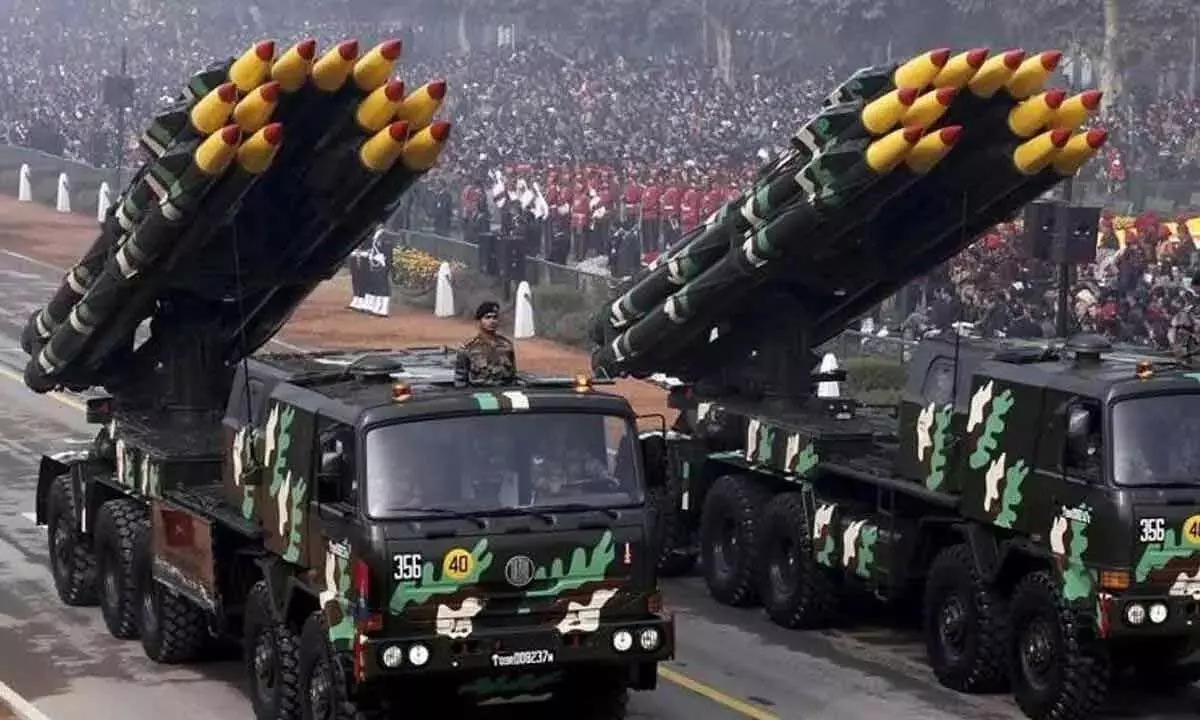Live
- India leads world in science, innovation research: Minister
- Flash flood in Indonesia's South Tapanuli claims two lives
- MahaYuti's electoral success testament to leadership of PM Modi, HM Shah: Ajit Pawar
- Unproven remedies: Tata Memorial Hospital slams Sidhu’s viral ‘diet cure’ cancer claim
- People voted in favour of development, rejected negative politics: CM Shinde
- Rajasthan bypolls: CM Bhajan Lal Sharma's governance credited with BJP's impressive show
- Aaditya Thackeray retains Worli defeating Shinde faction nominee Milind Deora
- Over 20 Injured in Multi-Vehicle Collision on Mangaluru-Bengaluru Highway
- South Korea not to attend Sado memorial amid controversy over Japan's pick for government representative
- Five major factors that helped MahaYuti to win landslide victory
Just In
Govt focussing on self-reliance in defence production


Govt focussing on self-reliance in defence production
India’s goal seems to have been to cut its dependence on other countries for defence systems across the board rather than to pivot from one supplier to the other
The world is fuelled by innovations. Adapting to new dimensions of development is probably what Indian defence does best. Encouraging innovations in the state of warfare is the best possible ears to the ground approach to take to maintain supremacy across your borders. Walk into the future of Indian warfare capabilities.
In the true spirit of adopting new technologies and innovating out of the box, these defence startups, MSMEs and entrepreneurs are trailblazers for their ability to create opportunities.
These defence manufacturers have adopted the role of innovative frontrunners with the larger picture in mind – that of unparalleled defence capabilities for our forces. The driving passion for them all is the need to make a mark in the history of Indian defence.
The report on Arms Production Capabilities in the Indo-Pacific Region, released by the Stockholm International Peace Research Institute (SIPRI) earlier this month, casts some 'serious doubts about whether India will be able to significantly reduce its dependence on imports in the short and medium term.
According to the report, 84.3 per cent of the major conventional arms procured by India in 2016-2020 were of foreign origin, of which licensed production accounted for 57.8 per cent. In a stark contrast, the domestic procurement accounted for a mere 15.7 per cent of the total procurement.
India emerged as the second-largest importer of arms transferred between 2016-20, with a share of 9.5 per cent of global arms imports. Even so, its imports fell 33 per cent from that between 2011-2015. The SIPRI report has attributed this decline to the country's complex procurement procedures and efforts to reduce its dependence on Russian weapons. Correspondingly, Russia has been the worst hit by India's decreased share, although it still ranks as the subcontinent's largest arms supplier, delivering 49 per cent of its total imports, ahead of France (18 per cent) and Israel (13 per cent). India has cleared weapon purchases worth Rs 28,732 crore, including armed drone swarms, carbines and bullet-proof jackets that will be designed and developed in the country. Surveillance and armed drone swarms feature on a new list of 'Make in India' projects that the army is pursuing in partnership with the defence industry. Drones within a swarm can carry out a wide range of missions, including strikes against tanks, infantry combat vehicles, ammunition holding areas, fuel dumps and terror launch pads.
For 2022-23, India has earmarked Rs 84,598 crore – 68 per cent of the military's capital acquisition budget – for the purchase of locally produced weapons and systems, besides setting aside 25 per cent of the defence research and development (R&D) budget for private industry, startups and academia. The DAC also approved a navy proposal to procure an indigenously-upgraded 1250 KW-capacity marine gas turbine generator for power generation on board the Kolkata-class of warships, and 14 fast patrol vessels for the Indian Coast Guard with 60 per cent indigenous content.
The government has imposed a phased ban on the import of 310 different types of weapons and systems. These include light weight tanks, naval utility helicopters, artillery guns, missiles, destroyers, ship-borne cruise missiles, light combat aircraft, light transport aircraft, long-range land-attack cruise missiles, basic trainer aircraft, multi-barrel rocket launchers, assault rifles, sniper rifles, specified types of helicopters, next-generation corvettes and airborne early warning and control (AEW&C) systems.
India's goal seems to have been to cut its dependence on other countries for defence systems across the board rather than to pivot from one supplier to the other.
There is, though, still much to be done. Three countries, namely Russia, France, and Israel, count India as the largest recipient of their defence exports. Such ties are operationally, diplomatically, and politically unviable to sever. Hence, India should find ways of becoming self-reliant that would not adversely affect relations with its partner countries. Engaging them to jointly develop and indigenously manufacture technologies, such as jet engines, missiles, swarm drones, and other AI-driven capabilities, is one such way.
Among many interesting trends that the report highlights, those on the changing landscape of India's defence procurement and manufacturing are noteworthy. Data provides us with a clearer picture as to where New Delhi stands in its quest to become atmanirbhar (self-reliant) in defence production, the progress it has made so far, and it's continued - albeit reduced - reliance on imported weaponry.
An added layer of defence lies in electronic warfare – being prepared for modern radars, anti-air and anti-ship missiles, lending superior edge in modern day warfare. From the Divya Drishti, Samyukta, Sangraha, Samudrika to the Shakti EWS, Indienous EWS are providing an added electronic layer of defence against modern radars, missiles and other threats to ensure dominance and survivability in today's modern battlefield.

© 2024 Hyderabad Media House Limited/The Hans India. All rights reserved. Powered by hocalwire.com






